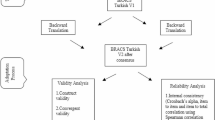Abstract
Background
Although voice therapy is commonly used as an initial treatment for geriatric dysphonia, its role in the treatment for different organic voice disorder is less defined.
Aims
The goal of this study was to investigate dysphonia and therapy modalities in this cohort.
Methods
This study analyzes the demographics, Voice Handicap Index questionnaires, and acoustic voice measures including fundamental frequency, jitter and shimmer by using Kay Elemetrics Computerized Speech Lab Multidimensional voice program which were obtained in all patients before and after treatment. A total of 91 (55 men and 36 women) patients with voice complaints, age ranging from 50 to 91 years (mean 64.11 ± 7.2) diagnosed of any vocal fold pathology were made via strobovideolaryngoscopy.
Results
Vocal nodules in 23.9 % (N = 22) was the most common diagnosis associated with the voice complaints, followed by laryngopharyngeal reflux in 10.8 % (N = 10) and paresis in 9.78 % (N = 9). VHI scores varied greatly, ranging from 4 to 92, with an average score of 42.7. Multidimensional voice program scores showed that fundamental frequency (F0) tends to rise as a function of age in men (mean 283.66 ± 23.7).
Discussion
Fundamental frequency perturbation may be affected in ageing, both genders same values detected. Of these patients, 80 % received hygienic voice therapy and % 20 symptomatic voice therapies. This study identified fundamental frequency alteration for ageing voice and dysphonia in all elderly patients presenting with voice complaints.
Conclusion
Additional research is needed to determine normative values for multidimensional voice program scores and other assessments in the elderly population.





Similar content being viewed by others
References
Von Leden H, Alessi DM (1993) The aging voice. In: Benninger M, Jacobson BH, Johnson AF (eds) Vocal arts medicine: the care and prevention of professional voice disorders. Thieme, NewYork, pp 269–280
Pontes P, Brasolotto A, Behlau M (2005) Glottic characteristics and voice complaint in the elderly. J Voice 19:84–94. doi:10.1016/j.jvoice.2004.09.002
Woo P, Casper J, Colton R et al (1992) Dysphonia in the aging: physiology versus disease. Laryngoscope 102:139–144. doi:10.1288/00005537-199202000-00007
Kandoğan T, Olgun L, Gültekin G (2003) Causes of dysphonia in patients above 60 years of age. Kulak Burun Bogaz Ihtis Derg KBB J Ear Nose Throat 11:139–143
Morrison MD, Gore-Hickman P (1986) Voice disorders in the elderly. J Otolaryngol 15:231–234
Hartman DE, Danhauer JL (1976) Perceptual features of speech for males in four perceived age decades. J Acoust Soc Am 59:713–715
Mysak ED (1959) Pitch and duration characteristics of older males. J Speech Hear Res 2:46–54
Stoicheff ML (1981) Speaking fundamental frequency characteristics of nonsmoking female adults. J Speech Hear Res 24:437–441
Linville SE, Fisher HB (1985) Acoustic characteristics of perceived versus actual vocal age in controlled phonation by adult females. J Acoust Soc Am 78:40–48
Morris RJ, Brown WS (1994) Age-related differences in speech variability among women. J Commun Disord 27:49–64
McGlone RE, Hollien H (1963) Vocal pitch characteristics of aged women. J Speech Lang Hear Res 6:164–170
Linville SE, Fisher HB (1985) Acoustic characteristics of women’s voices with advancing age. J Gerontol 40:324–330
Şenkal ÖA, Çiyiltepe M (2013) Effects of voice therapy in school-age children. J Voice 27:787-e19
Boone DR, McFarlane SC (1993) A critical view of the yawn-sigh as a voice therapy technique. J Voice 7:75–80. doi:10.1016/S0892-1997(05)80114-6
Roy N, Leeper HA (1993) Effects of the manual laryngeal musculoskeletal tension reduction technique as a treatment for functional voice disorders: perceptual and acoustic measures. J Voice 7:242–249. doi:10.1016/S0892-1997(05)80333-9
Denizoğlu II (2013) Lax Vox Ses Terapisinde Yöntem ve Uygulamalar The Lax Vox voice therapy: method and applications. Turkiye Klinikleri J ENT Spec Top 6:32–40
Wilson JA, Deary IJ, Scot S, McKenzie K (1995) Functional dysphonia. BMJ 311:1039–1040
Aronson AE, Bless DM (2009) Clinical voice disorders, 4th edn. Thieme, New York, pp 233–242
Boone DR, McFarlane S (1994) The voice and voice therapy, 5th edn. Prentice Hall Collage Div, Engelwood Cliffs
Berg EE, Hapner E, Klein A, Johns MM (2008) Voice therapy improves quality of life in age-related dysphonia: a case-control study. J Voice 22:70–74
Stemple JC (2005) A holistic approach to voice therapy. Semin Speech Lang 26:131–137. doi:10.1055/s-2005-871209
Roy N, Gray SD, Simon M et al (2001) An evaluation of the effects of two treatment approaches for teachers with voice disorders: a prospective randomized clinical trial. J Speech Lang Hear Res 44:286–296. doi:10.1044/1092-4388(2001/023)
Honjo I, Isshiki N (1980) Laryngoscopic and voice characteristics of aged persons. Arch Otolaryngol 106:149–150
Casper JK, Leonard R (2006) Understanding voice problems: a physiological perspective for diagnosis and treatment. Lippincott Williams & Wilkins, Philadelphia, pp 221–222
Gregory ND, Chandran S, Lurie D et al (2012) Voice disorders in the elderly. J Voice 26:254–258. doi:10.1016/j.jvoice.2010.10.024
Torre P III, Barlow JA (2009) Age-related changes in acoustic characteristics of adult speech. J Commun Disord 42:324–333. doi:10.1016/j.jcomdis.2009.03.001
Author information
Authors and Affiliations
Corresponding author
Ethics declarations
Conflict of interest
This study was approved by Anadolu University Institutional Review Board and Ethics Committee.
Statement of human and animal rights
We undersign, certificate that the procedures and the experiments we have done respect the ethical standards in the Helsinki Declaration of 1975, as revised in 2000 (5), as well as the national law.
Informed consent
For this type of study formal consent is not required.
Rights and permissions
About this article
Cite this article
Çiyiltepe, M., Şenkal, Ö.A. The ageing voice and voice therapy in geriatrics. Aging Clin Exp Res 29, 403–410 (2017). https://doi.org/10.1007/s40520-016-0597-3
Received:
Accepted:
Published:
Issue Date:
DOI: https://doi.org/10.1007/s40520-016-0597-3




